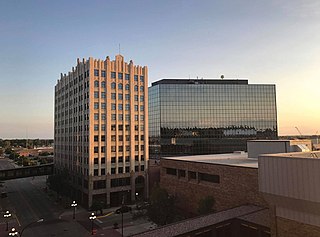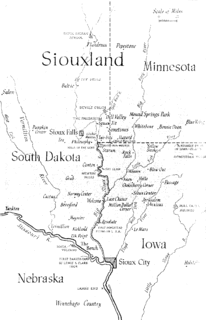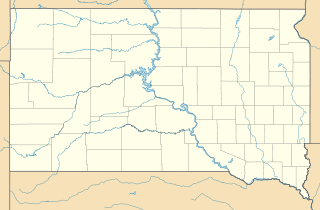
Interstate 29 (I-29) is an Interstate Highway in the Midwestern United States. I-29 runs from Kansas City, Missouri, at a junction with Interstate 35 and Interstate 70, to the Canada–US border near Pembina, North Dakota, where it connects with Manitoba Highway 75.

Scouting in South Dakota has a long history, from the 1910s to the present, and serves thousands of youth in programs that suit the environment in which they live.

Harrisburg is a city in Lincoln County, South Dakota, United States and is a suburb of Sioux Falls. The population was 4,089 by the 2010 census, having grown from 958 in 2000 census. The population of the Harrisburg zip code has grown from 2,476 in 2000 to 10,342 in 2010.

Yankton is a city in, and the County seat of, Yankton County, South Dakota, U.S. The population was 14,454 at the 2010 census. Yankton is the principal city of the Yankton Micropolitan Statistical Area, which includes the entirety of Yankton County, and which had an estimated population of 22,662 as of July 1, 2017. Yankton was the first capital of Dakota Territory. It is named for the Yankton tribe of Nakota (Sioux) Native Americans; Yankton is derived from the Nakota word I-hank-ton-wan.

Sioux City is a city in Woodbury and Plymouth counties in the northwestern part of the U.S. state of Iowa. The population was 82,684 in the 2010 census, which makes it the fourth largest city in Iowa. The bulk of the city is in Woodbury County, of which it is the county seat, though a small portion is in Plymouth County. Sioux City is located at the navigational head of the Missouri River. The city is home to several cultural points of interest including the Sioux City Public Museum, Sioux City Art Center and Sergeant Floyd Monument, which is a National Historic Landmark. The city is also home to Chris Larsen Park, commonly referred to as “the Riverfront,” includes the Anderson Dance Pavilion, Sergeant Floyd Riverboat Museum and Lewis and Clark Interpretive Center. Sioux City is the primary city of the five-county Sioux City, IA–NE–SD Metropolitan Statistical Area (MSA), with a population of 168,825 in 2010 and a slight increase to an estimated 168,921 in 2012. The Sioux City–Vermillion, IA–NE–SD Combined Statistical Area had a population of 182,675 as of 2010 and has grown to an estimated population of 183,052 as of 2012.

Siouxland is a vernacular region that encompasses the entire Big Sioux River drainage basin in the U.S. states of South Dakota, Minnesota, Nebraska and Iowa.

Sioux Falls Regional Airport, also known as Joe Foss Field, is a public and military use airport owned by the Sioux Falls Regional Airport Authority and located three nautical miles (6 km) northwest of the central business district of Sioux Falls, South Dakota, United States. Named in honor of aviator and Sioux Falls native Joe Foss, it serves the greater Sioux Falls area, as well as communities throughout eastern South Dakota, southwestern Minnesota and northwestern Iowa.

Sioux Falls Arena is a 7,500-seat multi-purpose arena located in Sioux Falls, South Dakota. The facility was built in 1961. It seats 6,113 for basketball games and 4,760 for indoor football and hockey.
The history of South Dakota describes the history of the U.S. state of South Dakota over the course of several millennia, from its first inhabitants to the recent issues facing the state.

Sanford Health is a non-profit, integrated health care delivery system, with its headquarters in Sioux Falls, South Dakota, with additional offices in Fargo and Bismarck, North Dakota, and Bemidji, Minnesota.
The following is a timeline of the history of the city of Sioux Falls, South Dakota, USA.
This timeline of South Dakota is a list of events in the history of South Dakota by year.
The 2006 NCAA Division II football rankings are from the American Football Coaches Association (AFCA). This is for the 2006 season.
The 2007 NCAA Division II football rankings are from the American Football Coaches Association (AFCA). This is for the 2007 season.
The 2011 NCAA Division II football rankings are from the American Football Coaches Association (AFCA). This is for the 2011 season.
The 2014 NCAA Division II football rankings are from the American Football Coaches Association (AFCA). This is for the 2014 season.

The flag of Sioux Falls, South Dakota, consists of a zigzag pattern of thin white and blue lines, which divides an upper blue portion and a lower pinkish-red portion, and a yellow sun in the upper left corner. The zigzag represents the namesake falls of the Big Sioux River. The blue color and the sun allude to the flag of South Dakota. The pinkish-red portion represents the Sioux Quartzite nearby. The upward direction of the design represents the growth of Sioux Falls. The red, white and blue colors included in the flag are also a reference to the flag of the United States while maintaining city and state pride.











